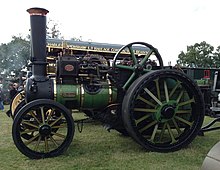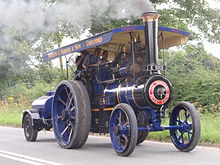Traction engine
A typical preserved traction engine: 1909 Burrell 6 nhp general purpose engine, at Great Dorset Steam Fair in 2018.
Traction engines tend to be large, robust and powerful, but heavy, slow, and difficult to manoeuvre. Nevertheless, they revolutionized agriculture and road haulage at a time when the only alternative prime mover was the draught horse.
They became popular in industrialised countries from around 1850, when the first self-propelled portable steam engines for agricultural use were developed. Production continued well into the early part of the 20th century, when competition from internal combustion engine-powered tractors saw them fall out of favour, although some continued in commercial use in the United Kingdom well into the 1950s and later. All types of traction engines have now been superseded in commercial use. However, several thousand examples have been preserved worldwide, many in working order. Steam fairs are held throughout the year in the United Kingdom, and in other countries, where visitors can experience working traction engines at close hand.
Traction engines were cumbersome and ill-suited to crossing soft or heavy ground, so their agricultural use was usually either "on the belt" – powering farm machinery by means of a continuous leather belt driven by the flywheel – or in pairs, dragging an implement on a cable from one side of a field to another. However, where soil conditions permitted, direct hauling of implements ("off the drawbar") was preferred – in America, this led to the divergent development of the steam tractor.
Aveling & Porter traction engine 'Avellana'
The traction engine, in the form recognisable today, was developed from an experiment in 1859 when Thomas Aveling modified a Clayton & Shuttleworth portable engine, which had to be hauled from job to job by horses, into a self-propelled one. The alteration was made by fitting a long driving chain between the crankshaft and the rear axle. Thomas Aveling is regarded as "the father of the traction engine". Other influences were existing vehicles which were the first to be referred to as traction engines such as the Boydell engines manufactured by various companies and those developed for road haulage by Bray. The first half of the 1860s was a period of great experimentation but by the end of the decade the standard form of the traction engine had evolved and would change little over the next sixty years.
Until the quality of roads improved there was little demand for faster vehicles and engines were geared accordingly to cope with their use on rough roads and farm tracks.
Right through to the first decades of the twentieth century, manufacturers continued to seek a solution to realise the economic benefits of direct-pull ploughing and, particularly in North America, this led to the American development of the steam tractor. British companies such as Mann's and Garrett developed potentially viable direct ploughing engines, however market conditions were against them and they failed to gain widespread popularity. These market conditions arose in the wake of the First World War when there was a glut of surplus equipment available as a result of British Government policy. Large numbers of Fowler ploughing engines had been constructed in order to increase the land under tillage during the war and many new light Fordson F tractors had been imported from 1917 onwards.
Preserved Burrell road locomotive pulling a water cart, near Jodrell Bank, Cheshire, England
Throughout the 1920s and 1930s there were tighter restrictions on road steam haulage, including speed, smoke and vapour limits and a 'wetted tax', where the tax due was proportional to the size of the wetted area of the boiler; this made steam engines less competitive against domestically produced internal combustion engined units (although imports were subject to taxes of up to 33%). As a result of the Salter Report on road funding, an 'axle weight tax' was introduced in 1933 in order to charge commercial motor vehicles more for the costs of maintaining the road system and to do away with the perception that the free use of roads was subsidising the competitors of rail freight. The tax was payable by all road hauliers in proportion to the axle load and was particularly restrictive on steam propulsion, which was heavier than its petrol equivalent.
Initially, imported oil was taxed much more than British-produced coal, but in 1934 Oliver Stanley, the Minister for Transport, reduced taxes on fuel oils while raising the Road Fund charge on road locomotives to £100 per year, provoking protests by engine manufacturers, hauliers, showmen and the coal industry. This was at a time of high unemployment in the mining industry, when the steam haulage business represented a market of 950,000 tons of coal annually. The tax was devastating to the businesses of heavy hauliers and showmen and precipitated the scrapping of many engines.
The last new UK-built traction engines were constructed during the 1930s, although many continued in commercial use for many years while there remained experienced engineers available to drive them.
From the 1950s, the 'preservation movement' started to build up as enthusiasts realised that traction engines were in danger of dying out. Many of the remaining engines were bought by enthusiasts, and restored to working order. Traction engine rallies began, initially as races between engine owners and their charges, later developing into the significant tourist attractions that take place in many locations each year. It has been estimated that over two thousand traction engines have been preserved.
Hornsby chain tractor (working scale model)
The machines typically have two large powered wheels at the back and two smaller wheels for steering at the front. However, some traction engines used a four-wheel-drive variation, and some experimented with an early form of caterpillar track.
Traction engines saw commercial use in a variety of roles between the mid-nineteenth and mid-twentieth centuries. Each role required a machine with a different set of characteristics, and the traction engine evolved into a number of different types to suit these different roles.
Agricultural (general purpose) engine
An agricultural engine, towing a living van and a water cart:
Ransomes, Sims & Jefferies Ltd 6 nhp Jubilee of 1908
"Big Lizzie", a purpose built tractor with two trailers, designed and built by Frank Bottrill using the Dreadnaught wheel
which he designed. When built "Big Lizzie" was the biggest tractor in
Australia and thought to be the biggest in the world, at 34 feet high by
18 feet wide, and weighing 45 tons.
US (agricultural) traction engine
Favourable soil conditions meant that US traction engines usually pulled their ploughs behind them, thereby eliminating the complexities of providing a cable drum and extra gearing, hence simplifying maintenance. American traction engines were manufactured in a variety of sizes, with the 6 nhp Russell being the smallest commercially made, and the large engines made by Russell, Case, and Reeves being the largest.Ploughing engine
A John Fowler & Co.
Ploughing Engine - the winding drum is mounted below the boiler (the
'drum' on the side is actually a hose for refilling the water tank). A
lockable tool box may be seen on the front axle; the 'spud tray' would
be mounted in the same way, behind the axle.
The winding drum was either mounted horizontally (below the boiler), vertically (to one side), or even concentrically, so that it encircled the boiler. The majority were underslung (horizontal), however, and necessitated the use of an extra-long boiler to allow enough space for the drum to fit between the front and back wheels. These designs were the largest and longest traction engines to be built.
Mostly the ploughing engines worked in pairs, one on each side of the field, with the rope from each machine fastened to the implement to be hauled. The two drivers communicated by signals using the engine whistles.
A variety of implements were constructed for use with ploughing engines. The most common were the balance plough and the cultivator - ploughing and cultivating being the most physically demanding jobs to do on an arable farm. Other implements could include a mole drainer, used to create an underground drainage channel or pipe, or a dredger bucket for dredging rivers or moats.
The engines were frequently provided with a 'spud tray' on the front axle, to store the 'spuds' which would be fitted to the wheels when travelling across claggy ground.
The man credited with the invention of the ploughing engine, in the mid-nineteenth century, was John Fowler, an English agricultural engineer and inventor. However a ploughing engine, devised by Peter, Lord Willoughby de Eresby and his bailiff George Gordon Scott, and constructed at Swindon Works, was exhibited at the Great Exhibition of 1851 in London, some years before Fowler's system appeared. Lord Willoughby had indicated that his design could be copied freely, and Fowler had visited Grimsthorpe Castle, the estate where the ploughing engines were deployed.
Ploughing engines were rare in the US; ploughs were usually hauled directly by an agricultural engine or steam tractor.
:o)







No comments :
Post a Comment